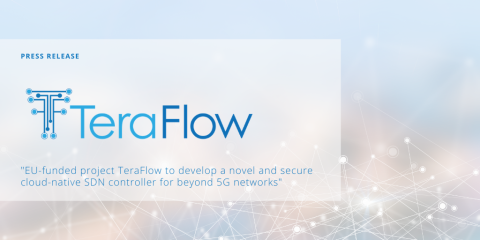The TeraFlow OS is based on container-based microservices deployed through agile DevOps processes and continuous integration and delivery (CI/CD) workflows, to enable transport network abstraction and interoperability across network devices from different vendors and network applications
Castelldefels, Spain. February 23, 2022. TeraFlow project, funded by the European Commission under Horizon 2020 Programme, has launched the 1st release of the TeraFlow OS, an innovative and robust SDN controller providing various microservices interacting with Network Function Virtualisation (NFV) orchestrators, and offering novel features for controlling and managing the underlying network infrastructure, including transport network elements (optical and microwave links), and IP routers.
The TeraFlow OS provides multiple benefits in terms of application resiliency and scalability for the monitoring of microservices and the accommodation of load requests with the creation of new instances, among many others. For this purpose, the TeraFlow OS has been designed and developed using a container-based architecture where each microservice provides precise functionalities by itself or in combination with other microservices.
Based on the degree of the interrelationship of microservices, TeraFlow OS provides core and netApps functionalities. TeraFlow core components are tightly interrelated and collaborate to provide a complete smart connectivity service through:
- Slice Manager Component: Uses the Network Slice Controller to realise a transport network slice, using physical and virtual network resources provided by underlying network controllers, managing both optical and packet resource domains.
- Service Component: Manages the lifecycle of the connectivity services established in the network, implementing an API to allow network operators to precisely define the service types, protocols and data models that need to be supported.
- Device Component: Handles the interaction with underlying network equipment with an API, enabling developers to implement new drivers to integrate them into the TeraFlow OS.
- Monitoring Component: Monitors the different metrics or Key Performance Indicators (KPIs) configured for the network devices and services, records the monitoring data associated with these KPIs, and provides a medium for other components to access the collected data.
- Compute Integration Component: Responsible for providing connectivity to external systems, such as NFV domains, by exporting a REST-API-based NorthBound Interface (NBI). Also translates external requests to be managed by the TeraFlow OS components.
- Distributed Ledger Component: Provides a distributed ledger to record, query and process relevant data for network management and detection of compromised edge devices. Also, records slice requests in the blockchain.
- Traffic Engineering Component: Responsible for setting up and optimising Segment Routing paths in the infrastructure which are exposed by the Device component considering the constraints and available resources.
- Automation Component: With zero-touch interventions nor local configuration, adds and updates a physical or virtual device, SDN controllers or management tools to the network, while ensuring that the correct certificates, software, configuration parameters and pipeline definition are installed.
- Policy Management: Translates high-level policy rules to the actual configuration in an automatic manner to either physical or virtual devices.
- Context Manager: Stores the configurations and attributes of the different network elements managed by the TeraFlow OS, such as contexts, topologies, devices, links and services created.
On the other hand, TeraFlow netApps consume the core micro-services via standardised APIs to provide necessary carrier-grade features dedicated to addressing current needs related to:
- Load balancing: Allowing the distribution of flow and slice requests among the micro-services component replicas.
- Cybersecurity: Providing AI/ML-based mechanisms to detect network intrusions and harmful connections while delivering countermeasures to security incidents.
- Autoscaling: Directing the autonomous replication of micro-services to support a high number of incoming requests.
- Self-healing: Monitoring micro-services and per-flow status to apply healing mechanisms from a control and data plane perspective.
- Inter-domain smart connectivity services: Allowing the interaction of a TeraFlow OS instance with peer ones managing different network domains.
To validate the performance of the components developed and their potential contribution to end-users and early adopters of the TeraFlow OS, three scenarios have been selected, representing some of the challenges from B5G networks and the specific features provided by TeraFlow’s components to overcome them: Autonomous Network Beyond 5G, Automotive and Cybersecurity.
The source code of the first version of the TeraFlow OS SDN Controller is publicly available for download and installation at the GitLab repository: https://gitlab.com/teraflow-h2020/controller. The next major release of the 2nd version of the TeraFlow OS will take place on January 2023. Nevertheless, until that moment minor releases will be done to provide bug fixing and additional features identified on the testing and validation activities.
Quotes:
“TeraFlow OS brings the power of cloud-native solutions to your SDN networks.” by Ricard Vilalta, Senior Researcher at CTTC and TeraFlow Project Coordinator
_____________________
Follow TeraFlow on Twitter and LinkedIn, and subscribe to its newsletter for being up to date with all the progress
About TeraFlow:
TeraFlow – Secured autonomic traffic management for a Tera of SDN flows - is an EU-funded project under the Research and Innovation programme H2020 with the Grant Agreement Nº 101015857. TeraFlow will create a new type of secure cloud-native SDN controller that will radically advance the state-of-the-art in beyond 5G networks.
For further information about the project please contact TeraFlow Project Coordinator, Ricard Vilalta, CTTC: ricard.vilalta@cttc.es, and for any media/dissemination enquiries contact TeraFlow Communication Manager, Ana María Morales, Atos Spain: ana.morales@atos.net
